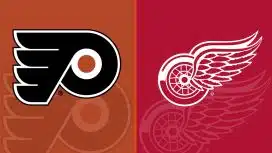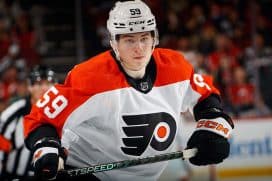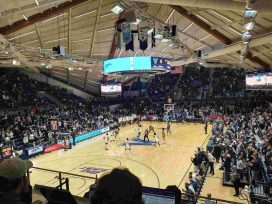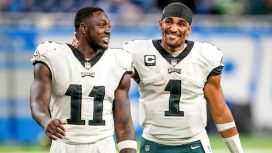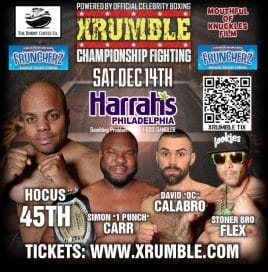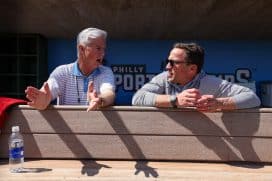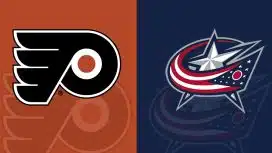Phillies
Top 25 Phillies of All-Time: No. 15 – Johnny Callison
By: Matt Veasey, Sports Talk Philly Staff
Johnny Callison was born into a poor family in rural Oklahoma in 1939 during the Great Depression. He was then raised as a small child mostly by his mother while his father, who was part Cherokee Indian, was off fighting with the United States Army in World War II.
While his father was away, his mother packed up he and his brother and two sisters and moved the clan out to California, settling in Bakersfield. Per an outstanding bio on Callison written by Steve Wulf for ESPN back in 2013, Callison befriended a group of Mexican kids who nicknamed him "Okie" due to his former home. Wulf's bio of Callison is a must-read for any fan of the player.
Callison found during his youth in California that he had tremendous athletic ability. According to his bio at SABR by John Rossi, one of Callison's teachers "noted that he could run faster backward than most of his classmates could run forward."
Joining his local little league team, Callison learned the game of baseball from his coach, Jim Boone. The former Negro Leaguer tutored Callison in all facets of the sport before the coach was tragically shot to death by his wife. It was one more rough chapter in the life of young Callison, who at home was caught between his churchgoing mother and alcoholic father.
Callison battled through his rough home life by immersing himself in sports, particularly baseball. He became a star at East Bakersfield High, came to the attention of scouts, and was ultimately signed by the Chicago White Sox.
A natural power-speed combination as a ballplayer, Callison rocketed through the White Sox minor league system over three seasons from 1957-59. Callison received his first promotion to the big leagues in September of 1958, and made the big league roster out of spring training the following year.
Despite appearing in 49 games as a 20-year old in that 1959 season, Callison would not make the White Sox roster for the World Series after the team won the American League pennant. The Sox would drop that Fall Classic in six games to the Los Angeles Dodgers, and as it would turn out, Callison would never play postseason baseball.
On December 9, 1959 he finally got what would turn out to be his biggest break when Callison was dealt by the White Sox to a young, losing Philadelphia Phillies team in exchange for infielder Gene Freese.
In Philly, Callison appeared in 99 games in the 1960 season, and then won a full-time starting job by 1961. At age 23 in the 1962 season, Callison became an NL All-Star for the first of what would be three times in his career.
Hitting for a .300 average with 23 homers, 83 RBI, and 107 runs scored, Callison also received MVP votes for that 1962 season, the first of four consecutive years that he would be considered.
With Callison as part of a young lineup core that included slugging third baseman Don Demeter, talented center fielder Tony Gonzalez, rugged catcher Clay Dalrymple, and slick-fielding shortstop Bobby Wine, the Phillies recorded a winning season in 1963. That year's club finished at 81-80, the first winning campaign for the franchise in a decade.
In 1964 the Phillies welcomed their top minor league prospect to the lineup, and Dick Allen immediately became a star and impacted the lineup with an NL Rookie of the Year campaign. Allen and Callison became a strong combination in the middle of the Phils' lineup, with Callison enjoying his best season.
That 1964 team led the National League for much of the summer, building a 7.5 game lead by late August. Callison would finish as the NL MVP runner-up after a season in which he would produce 31 homers, 30 doubles, 10 triples, 104 RBI, and 101 runs scored.
Famously, the 1964 team would collapse down the stretch. Holding a 6.5 game lead on the morning of September 21st, the Phillies would lose 10 straight to finish a game behind the Saint Louis Cardinals.
During those early-mid 1960's peak years, Callison was often compared to a far more high-profile ballplayer in the other league, New York Yankees superstar Mickey Mantle.
While the Phillies would continue as a winning team for the next three seasons, they would never again come close to a National League pennant with that group. Callison had one more big season in 1965, leading the league in triples, and would lead the league in doubles in the 1966 season.
But his results steadily declined as he began feuding with manager Gene Mauch. At the end of the 1969 season in which he turned 30 years old, Callison was dealt to the Chicago Cubs for outfielder Oscar Gamble and pitcher Dick Selma.
Callison had one final good season in 1970, slamming 19 homers with the Cubs, and that would be his last as a full-time starter. He hung on for one more year in Chicago before being dealt to the Yankees in January of 1972. He would wind down his career coming off the bench in the Bronx for 45 games in 1973 before retiring after his release at age 34.
After retiring, Callison was a part of a number of business ventures, and took part regularly in the Phillies fantasy camps. As he aged, his health deteriorated. Battling ulcers and having suffered a heart attack, Callison would eventually die of cancer in October of 2006 at age 67. He left behind his high school sweetheart wife, Dianne, and three daughters.
In 1997, Callison had been voted into the Phillies Wall of Fame. The 19th player selected at that point, he joined 1964 teammates Allen, Jim Bunning, and Chris Short to be so honored. They have since been joined by two further teammates, Tony Taylor and Dallas Green. In 2012, Callison was posthumously inducted into the Philadelphia Sports Hall of Fame.
Career Accomplishments
Callison played parts of 10 seasons with the Phillies, and aside from Hall of Famer Chuck Klein may have been the best right fielder in the history of the ball club.
He led the National League in triples in 1965 and doubles in 1966, tying for the NL lead in triples in 1962. He registered double-digit figures in that triples category for five consecutive seasons from 1961-65. On June 6th of 1965, Callison powered to a three-homer game at Wrigley Field.
A tremendous defender, Callison led the National League in fielding average among right fielders in both 1963 and 1964. He led the National League in outfield assists and double plays in 1962, and in assists again over each of the next three seasons.
A three time National League All-Star, he received MVP votes in four consecutive seasons from 1962-65, finishing as the runner-up for the 1964 campaign.
Most Memorable Moment
Callison was an National League All-Star in 1962 and again in the 1964 and 1965 seasons. The most memorable moment of his big league career, or at the very least the one for which he is most remembered by the wider baseball community, came in the 1964 MLB All-Star Game.
He did not start that game for the National League, which began the midsummer classic with a trio of Hall of Famers in the outfield. Billy Williams of the Cubs started in left, Willie Mays of the Giants in center, and Roberto Clemente of the Pirates in right field.
In the bottom of the 5th inning, Callison was sent in to pinch-hit for Bunning, his Phillies teammate, and would pop out to shortstop. In the bottom of the 7th, Callison flew out to deep center field, nearly tying the game as the NL trailed 4-3.
The game went to the bottom of the 9th with the National League still trialing by that 4-3 score. Mays led off with a walk from tough Boston right-hander Dick Radatz, and with Orlando Cepeda at the plate, the "Say Hey Kid" stole second base.
Cepeda then blooped a base hit to score Mays and tie the game at 4-4, and Curt Flood was sent in as a pinch-runner. After Radatz got Ken Boyer to pop out to thirrd, catcher Johnny Edwards was intentionally walked to bring the weak-hitting Ron Hunt to the plate.
However, National League manager Walter Alston then played his trump card, bringing to the plate 30-year-old superstar Hank Aaron, who had been held back to that point for just such a moment. However, Radatz won the battle, striking Aaron out and bringing Callison to the plate.
With two outs and two men on base and the game tied at 4-4, the 25-year-old Phillies right fielder stepped in to the box. On the first pitch, Callison drove a blast deep to right field and over the Shea Stadium wall for a game-winning home run. It was one of only three walkoff homers in MLB All-Star Game history. For the winning blast, Callison was awarded the 1964 MLB All-Star Game MVP award.
Reasons for Ranking Placement
Callison produced an 8+ WAR season in 1963, and a trio of 5+ WAR seasons in 1962 and again in 1964-65 during his peak as a player. In each of his final three seasons with the Phillies from 1967-69, Callison produced a 2+ WAR season (he had just missed a fourth with a 1.9 mark in 1961).
On the Phillies all-time career lists, Callison played 10 seasons in Philadelphia and ranks as follows: Hits (16), Runs (16), Doubles (13), Triples (6), Home Runs (12), RBI (18).
STP Top 25 Phillies of All-Time (to date)
- No. 25, Garry Maddox
- No. 24, Roy Thomas
- No. 23, Gavvy Cravath
- No. 22, Chris Short
- No. 21, Cy Williams
- No. 20, Curt Schilling
- N0. 19, Cole Hamels
- No. 18, Ryan Howard
- No. 17, Sam Thompson
- No. 16, Del Ennis
Formula Explanation
The player rankings formula combines both traditional and advanced statistics/metrics and assigns a point total to each category. These statistics only reflect the player's Phillies career.
